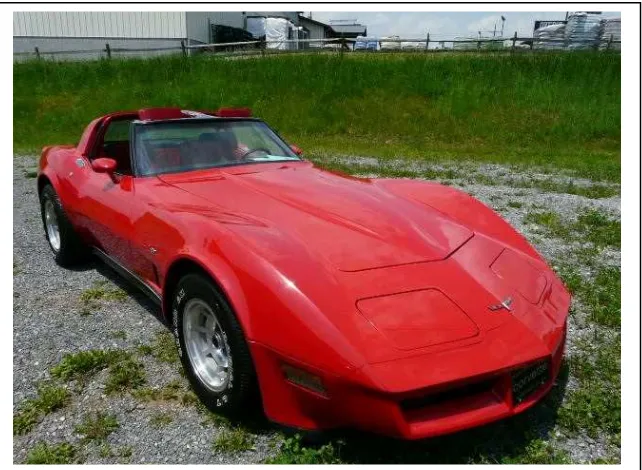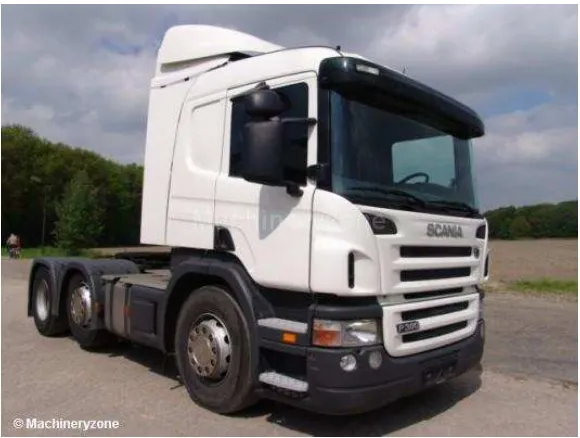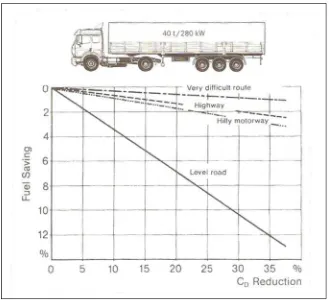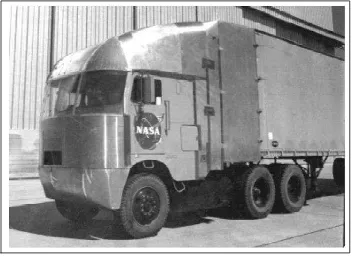AERODYNAMIC STUDY OF HEAVY TRUCK USING CFD FLUENT
HILMI SAFUAN BIN JAPAR
“I hereby verify that I have read this report and I find it sufficient in term of quality and scope to be awarded with the Bachelor Degree in Mechanical Engineering “
Signature : ………
Supervisor Name : ………
AERODYNAMIC STUDY OF HEAVY TRUCK USING CFD-FLUENT
HILMI SAFUAN BIN JAPAR
This report is submitted to Faculty of Mechanical Engineering in partial fulfill of the requirement of the award of Bachelor’s Degree of Mechanical Engineering
(Thermal-Fluid)
Faculty of Mechanical Engineering
UNIVERSITI TEKNIKAL MALAYSIA MELAKA
i
“I hereby to declare that the work is my own except for summaries and quotations which have been duly acknowledge”
Signature : ……….
DEDICATION
To him who is our source of grace, our source of commitment, and our source of knowledge,
And,
iii
ACKNOWLEDGMENT
All praises to the Almighty Allah, for giving me the strength, patience and guidance throughout the process of completing this investigation. I am grateful to have the morally and physically support from many people throughout completing this study. For this opportunity, I would love to thank whose are either directly or indirectly involved during the process of this research is conducted.
Most immediately, I would like to express my very special gratitude and appreciations to my supervisor, Mr. Mohd Afzanizam bin Mohd Rosli for his valuable suggestion, comments and advice in every stage of this project. All the discussion makes me understand every detailed in this road vehicle aerodynamic analysis.
ABSTRACT
v
ABSTRAK
Aerodinamik adalah satu kajian tentang aliran udara sekitar sesuatu objek. Di dalam aplikasi terhadap kenderaan darat, aerodinamik merupakan salah satu aspek penting terhadap kenderaan tanah selain enjin dan suspensi. Rekaan yang halus diperlukan bagi mengurangkan rintangan udara terhadap kenderaan pada kelajuan tinggi, kerana rintangan udara akan meningkat seiring dengan peningkatan halaju. Computational Fluid Dynamic adalah satu lagi kaedah untuk mengkaji aliran udara
TABLE OF CONTENT
CHAPTER CONTENT PAGE
DECLARATION i
DEDICATION ii
ACKNOWLEDGEMENT iii
ABSTRACT iv
TABLE OF CONTENT vi
LIST OF TABLES ix
LIST OF FIGURES x
LIST OF GRAPH xii
CHAPTER 1 INTRODUCTION
1.1 Research Background 1
1.2 Objective 4
1.3 Research Scope 4
1.4 Problem Statements 5
1.5 Project Discussion 6
1.6 Significant of Research 6
CHAPTER 2 LITERATURE REVIEW
2.1 Introduction 7
2.2 Relationship between Aerodynamic and Fuel
Consumption 7
vii 2.4 Fundamental of Aerodynamic in Vehicle 13
2.4.1 Boundary Layer 15
2.4.2 Coefficient of Drag 16 2.4.3 Coefficient of Lift 17 2.4.4 Pressure Distribution 19 2.4.5 Reynolds Number 21
2.5 Wind Tunnel 22
2.6 Summary 22
CHAPTER 3 METHADOLOGY
3.1 Introduction 23
3.2 Process Flow 24
3.2.1 Literature Review Process 25 3.2.2 Model Development Process using Solid
Work 25
3.2.3 GAMBIT Meshing and Defining Overview 26 3.2.4 Wind Tunnel Study and Scaled Analysis 27 3.3 Step of Model Designing using Solid work 28
3.3.1 Solid Work Design 28
3.3.2 Hand-made Model Truck 32
3.4 GAMBIT and FLUENT analysis 35
3.5 Wind Tunnel Testing 39
CHAPTER 4 DATA AND RESULT ANALYSIS
4.1 Introduction 41
4.2 Wind Tunnel Result 41
4.3 CFD-Fluent Result 45
4.4 Sample of Calculation 49
4.4.1 Wind Tunnel Force Calculation 49 4.4.2 Coefficient of Drag Calculation 49
CHAPTER 5 RESULT AND DATA DISCUSSION
5.1 Introduction 51
5.2 Wind Tunnel and CFD Simulation Comparison 51 5.3 Square-cab Design and Tri-cab Design
Comparison 52
5.4 Cab Angle 54
5.4.1 Square-cab Design 54
5.4.2 Tri-cab Design 56
5.5 Fuel Consumption Effect 58
5.5.1 Fuel Consumption on Square-cab Truck 59 5.5.2 Fuel Consumption on Tri-cab Truck 60 5.5.3 Fuel Consumption on Truck without
Roof-cab 62
5.5.4 Comparison of Truck with Roof-cab and
without Roof-cab 63
CHAPTER 6 CONCLUSION AND RECOMMENDATION
6.1 Conclusion 64
6.2 Recommendation 65
REFERENCE 69
APENDICE A: Simple and Low-Cost Aerodynamic Drag Reduction
Devices for Tractor-Trailer Trucks 71
APENDICE B: Progress in Reducing Aerodynamic Drag for Higher
ix
LIST OF TABLES
NUMBER TITLE PAGE
1.1 Range of coefficient of drag for various type of vehicle 3 2.1 Standard force and moment of vehicle. 14
3.0 Boundary Types Identification 38
4.0 Truck Identification 42
4.1 Model Wind Tunnel Results 42
4.2 CFD Simulation Results 43
4.3 Square-cab Truck Coefficient of Drag 44
4.4 Tri-cab Truck Coefficient of Drag 46
LIST OF FIGURES
NUMBER TITLE PAGE
1.1 1980 Chevrolet Corvette T-Top 2
1.2 P-130 SCANIA Truck 5
2.0 Influence of drag on fuel consumption for a 40 tons trailer 8 2.1 Tractor semi-trailer configuration 9 2.2 Air flow on Truck without CVTD 10 2.3 Air flow on Truck without USD and VSD 11
2.4 Cross Flow Vortex Trap Device 11
2.5 Vortex Strake Trailer Device 12
2.6 Undercarriage Flow Device 12
2.7 Road vehicle axis system 15
2.8 Boundary Layers 15
2.9 Boundary layer occurs on the roof of a bus 16 2.10 Coefficient of drag for heavy vehicle 17
2.11 Effects of underfloor to ground clearance on air speed,
pressure and lift force 18
2.12 Pressure distribution above and below the body structure 19 2.13 Trailer floe body pressure distribution with and
without roof deflector 20
3.1 Model Development by Solidwork 26
3.2 Diagram of Wind tunnel testing 28
xi
3.4 45° Square-cab Truck 29
3.5 60° Square-cab Truck 30
3.6 30° Tri-cab Truck 30
3.7 45° Tri-cab Truck 31
3.8 60° Tri-cab Truck 31
3.9 Sand Paper 32
3.10 Nexa Auto Color 32
3.11 1.2” Screw 32
3.12 Wind Tunnel Testing 40
3.13 Fan Controller 40
3.14 Force Indicator 40
5.0 Square-cab Truck Pressure Distribution 53
5.1 Tri-cab Truck Pressure Distribution 53
5.2 Square-cab Truck at 45° 55
5.3 Square-cab Truck at 60° 55
5.4 Turbulence Occur On the Truck 55
5.5 Pressure Distribution Contour for Tri-cab 30° 56 5.6 Pressure Distribution Contour for Tri-cab 45° 57 5.7 Pressure Distribution Contour for Tri-cab 60° 57
5.8 Drag Coefficient Properties 58
5.9 Rate of Fuel Consumption for 30° Square-cab Truck 59 5.10 Rate of Fuel Consumption for 30° Tri-cab Truck 61 5.11 Rate of Fuel Consumption for Truck without Roof-cab 62 6.0 Research on truck with different container height 65 6.1 Position of the overhead cab at lower container height 66 6.2 Position of the overhead cab at higher container height but still
maintain 30° angle 67
LIST OF GRAPH
NUMBER TITLE PAGE
4.0 [Truck 1/52 scale] Coefficient of Drag versus Velocity (m/s) 44 4.1 [Truck 1/1 scale] Coefficient of Drag versus Velocity (m/s) 44 4.2 Square-cab Truck, Drag Coefficient versus Velocity (m/s) 47 4.3 Tri-cab Truck, Drag Coefficient versus Velocity (m/s) 47
1
CHAPTER 1
INTRODUCTION
1.1 Research Background
Aerodynamics is a branch of fluid dynamics concerned with the study of gas flows. The solution of an aerodynamic problem normally involves calculating for various properties of the flow, such as velocity, pressure, density, and temperature, as a function of space and time. Understanding the flow pattern makes it possible to calculate or approximate the forces acting on bodies in the flow.
Figure 1.1: 1980 Chevrolet Corvette T-Top (Source: www.automagazineonline.com)
The road vehicle aerodynamic is important for increasing the performance of the vehicle with less fuel consumption; furthermore, it also will improve stability of the vehicle. A smooth airflow around the vehicle will reduce drag on the vehicle itself, which will also reduce the engine load, as the engine load reduce, fuel consumption may reduce as well, hence giving the user the opportunity for financial saving. Other then increasing engine performance, air flow will also increase the stability of the vehicle at high speed, as the vehicle is stable at high speed the safety of the passengers were assured and the passenger may arrive at they destination in a short time.
3
Aerodynamic characteristic is not obvious at low speed, but as the speed increase the air resistances are also increase. At this occasion more energy is needed form the engine to overcome the air resistance. The common highway speed today is at 110 km/h, to overcoming aerodynamic drag represents about 65% of the total energy expenditure for a typical heavy truck vehicle. Reduced fuel consumption for heavy vehicles can be achieved by altering truck shapes to decrease the aerodynamic resistance (drag). It is conceivable that present day truck drag coefficients might be reduced by as much as 50%.
[image:18.612.100.542.378.504.2]A modern Class 7-8 tractor-trailer can weigh up to 8 tons and has a wind-averaged drag coefficient around CD=0.55 to 0.80. The drag coefficient is defined as the drag/ (dynamic pressure x projected area).
Table 1.1: Range of coefficient of drag for various type of vehicle (Source: Barnard, R.H. [2001])
The objective of this research is:
i. To study the existing heavy truck aerodynamics.
ii. To compare two roof-cap design, and study the effect to the truck.
iii. To propose a better design of roof-cap complies with good aerodynamics
features.
1.3 Research Scope
i. Study an existing heavy truck aerodynamics specifically in Malaysia.
ii. Comparing two design of roof cab and propose the best aerodynamic features.
iii. Develop a CFD model and perform the airflow study of the heavy truck
aerodynamic.
iv. Conduct a wind tunnel testing to validate the CFD simulation.
In this research, SCANIA P380 was chosen as a model for study because it is
one of Malaysia most popular heavy truck. This research will focus on Computational
Fluid Dynamic (CFD). Nevertheless, the validation of the CFD result will be done in the
wind tunnel experiment where in this experiment further aerodynamic characteristic will
be understood by the researcher. The research will be conducted using Solid work,
GAMBIT and FLUENT software, where Solid work as a model builder, GAMBIT as a
modeler and FLUENT as a simulator. As for experiment, wind tunnel facility will be
used to investigate the aerodynamic of the truck model. The tunnel that will be used is
5
1.4 Problem Statements
Initially, the author has a problem in choosing type of truck that would be the
most suitable truck to be analyzed. It is found that SCANIA is the favorite heavy duty
vehicle manufacturer in Malaysia not only that because it’s have been here since 1971
but also the technology behind the wheel were competitive with other truck
manufacturer. As we can see, SCANIA have been used for container transportation, fire
fighting, cargo transport and buses.
P-130 model have been choose because it is the latest model of class 8 truck in
SCANIA manufacturing industry. The model that the author will develop from solid
work will not be the exact dimension with the real model; some of the truck
specification will not be inserted in the truck drawing model. Specifications of the truck
model that will be neglected in the solid work model is: • Side mirror.
• Truck side doors.
[image:20.612.177.467.413.632.2]• Details of the truck such as bolt nut, tires detail etc.
In starting the project, expecting the worst case scenario would be the best step of doing the project, hence, several limitation have been expected to interrupt the project or change the method of the project. Limitation is problems that occur during completing this investigation and we cannot avoid it. There are a few limitations during the wind tunnel experimental test and listed as follows:
1. The maximum speed can be used of the wind tunnel approximately 30m/s or 108km/h because it is a subsonic downstream fan type. 2. Since the wind tunnel test section is a 1ft x 1ft, the wind tunnel size is
not suitable for scale model within the range 1:1 to 1:10 due to blockage factor. The maximum scale model can be used for road vehicle is 1:20.
1.6 Significant Of The Research
7
CHAPTER 2
LITERATURE REVIEW
2.1 Introduction
Literature review is about understanding the theory of the research that being done, it is considered as the most important part of research where at this part the researcher will understand the theory, then proceed with the project by referring to the theory as a guide. The information about the research theory can be found through internet thesis, journal and reference book. In this research case, all the theory or information about fundamentals of aerodynamic, vehicle aerodynamic and heavy truck aerodynamic are needed as a reference.
2.2 Relation between Aerodynamic and Fuel Consumption
Figure 2.0: Influence of drag on fuel consumption for a tractor-trailer. (Source: H.Gǘtz, 1982.)
9
2.3 Cab Shape
In truck aerodynamic improvement, cab shape plays the most important roles in reducing drag. By referring to Richard, M.W. (2003), at low speed, the mass of the truck will influence the engine load of the truck, but as the truck speeding more then 80 KM/H, aerodynamic of the truck will influence the engine load. Since in highway, trucks were speeding until approximately 100KM/H it is essential that aerodynamic improvement need to be done to reduce operating cost.
[image:24.612.176.528.364.621.2]A research title Reassessment of Heavy-Duty Truck Aerodynamic Design Features done by Edwin J.S. and Robert R. Meyer, Jr, (1999) under NASA. The report describe that the aerodynamic of the truck need to be done because of the fuel crisis that hunted the transportation industry. The goal of the research is to prove that the combination of tractor-semitrailer (as shown in figure 2.1) aerodynamic configuration will reduce conventional truck coefficient of drag.




